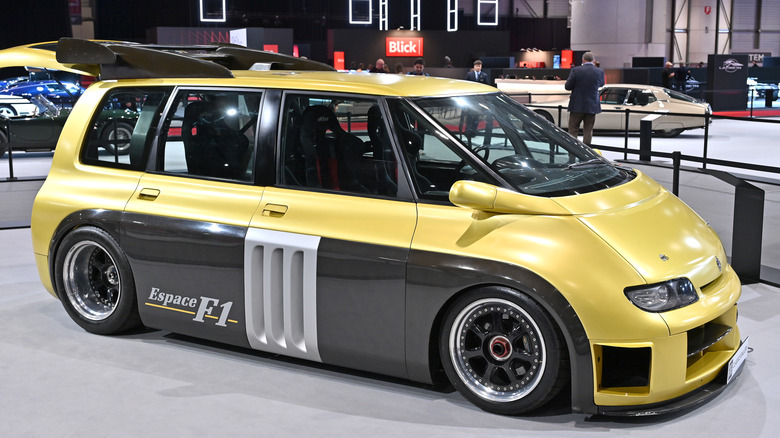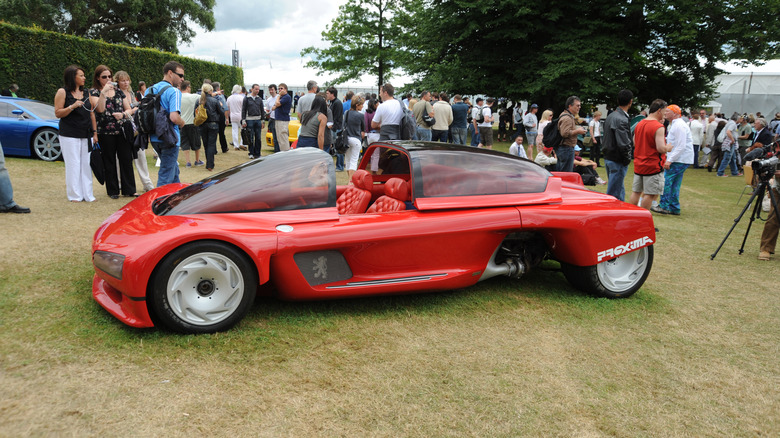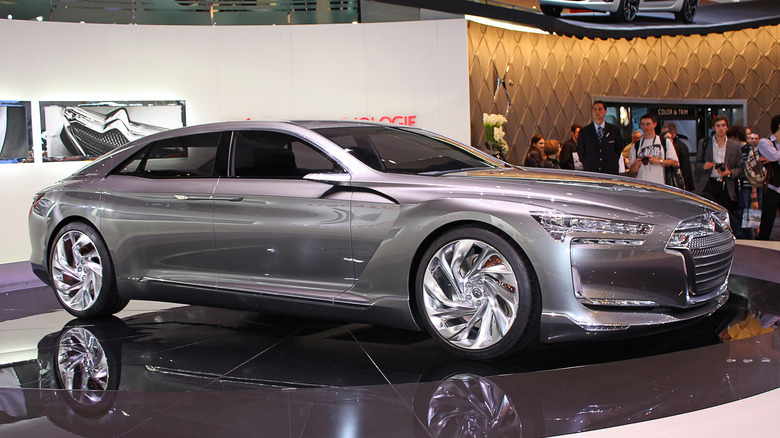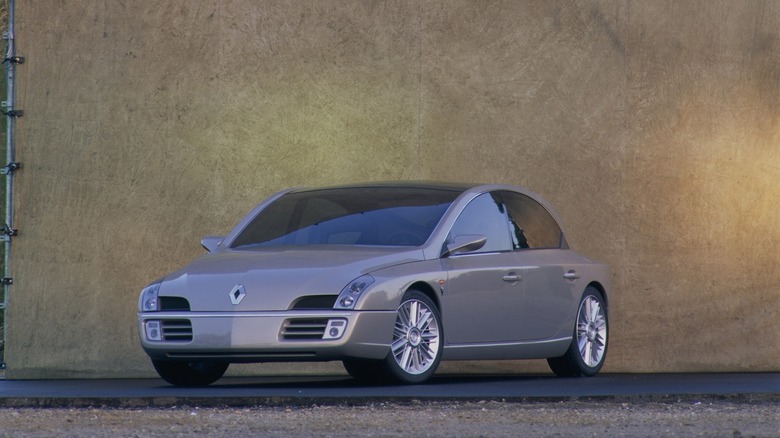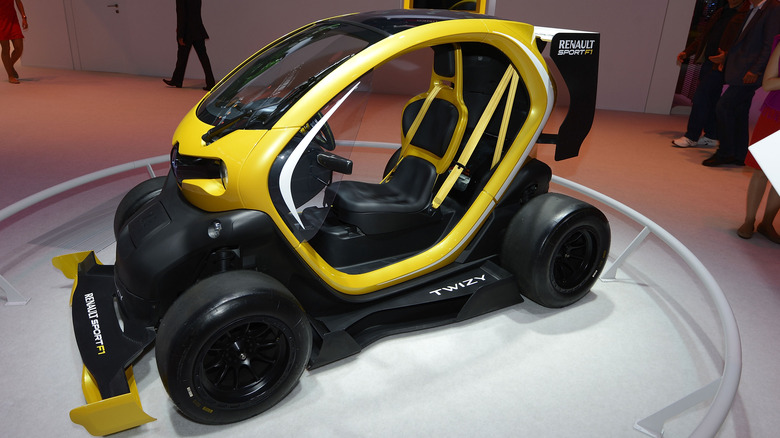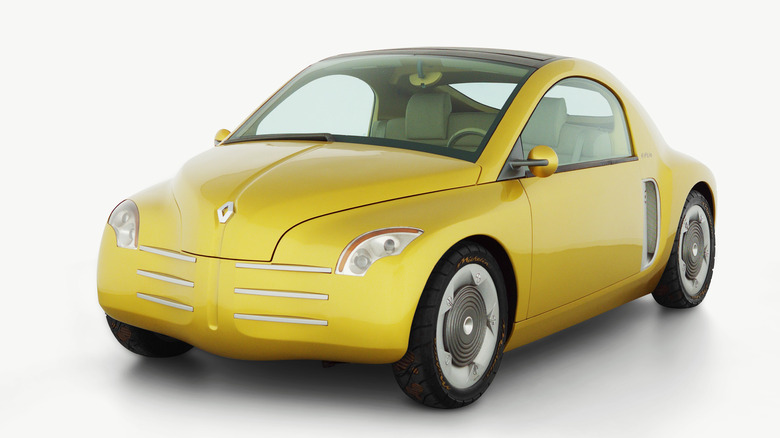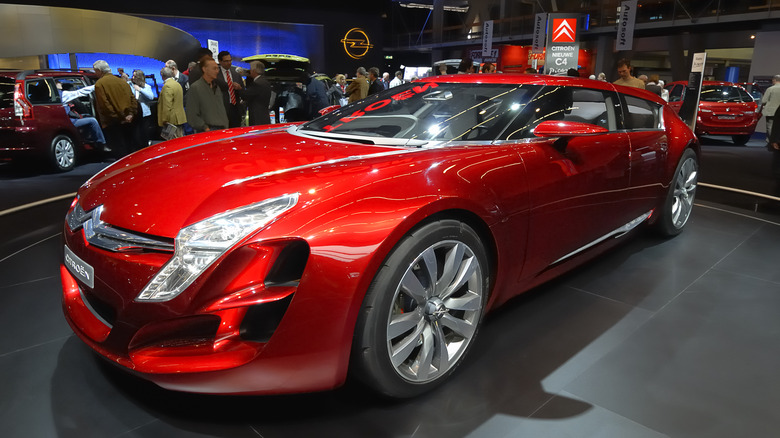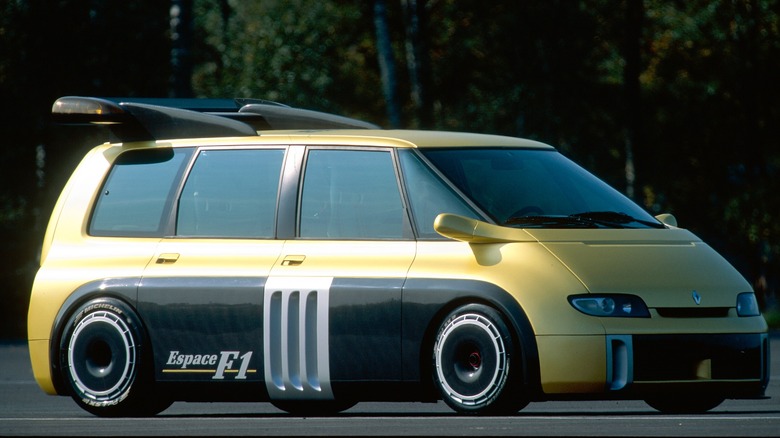The 10 Most Ridiculous French Concept Cars We Wish Made Production
Concept cars serve a purpose. The automakers say that it's to showcase future production models or future technologies, but in a lot of cases, their actual purpose is to make enthusiasts yearn for them to reach production. Sadly, oftentimes, they don't. As concept cars are never confined to regulations, automakers can truly go crazy with them in just about every aspect.
We've seen our fair share of cool concept cars from all over the world, and some of them really did go into production with little to no changes (see Jaguar C-X16, among others). However, most remain purely an item of the design and engineering teams' fantasies. But what happens when French companies make a concept car?
The answer is, more often than not, some properly unique stuff. Companies like Renault, Peugeot, and more are already known for rebelling against the established norms of design even in production cars, so you can imagine what happens when their design teams and engineers really let their hair down. Frankly, it's really disappointing that these French concept cars never actually made production.
Peugeot Proxima
One look at the Peugeot Proxima makes you wonder, why didn't CD Projekt Red just license this to appear in "Cyberpunk 2077" instead of the Porsche 911? The Proxima was introduced in 1986 at the Paris Motor Show, and it was unlike any other supercar in the world. As you can see, the most notable aspect of its design is that the rear wheels are almost entirely separated from the bodywork, each with their own aero cover.
Every angle of the Proxima just screams "the future" seen through a 1980s lens, not to mention the loud red paint scheme and those wheels that look modern even by today's standards. Of course, a car that looks like this needs to have a proper powertrain to back that all up. Luckily, Peugeot pulled out all the stops there, too.
Powering the Proxima is a turbocharged 2.9-liter V6 putting out 600 hp and nearly 450 lb-ft of torque, absolutely insane by the standards of 1986. Remember, the Porsche 959 came out the same year and put out 444 hp. The Proxima delivered all that grunt to all four wheels through a sequential gearbox, and it weighed an almost unfathomable 2,380 pounds. Inside, there was a lot of red, and a lot of screens, before that whole thing was cool. How do you enter? Through the extremely '80s sliding glass canopy, of course.
Citroen Metropolis
Citroen's final attempt at a proper luxury car, the C6, went out of production in 2012, and it went out as one of many luxury car underdogs of the 2000s. While the C6 did return in 2017, it was a Chinese-market exclusive and the styling could best be described as underwhelming. However, in 2010 Citroen showed the world the absolutely show-stopping Metropolis concept. This is what the second generation C6 should have been.
First of all, take a moment and just look at how massive the car is and how much presence it has. The proportions and the general look are pure class, and you can tell that the design team really put a lot of effort into it. Then again, at 17.4 feet long, longer than the LWB BMW 7 Series of the time, it better have some presence.
Although the Metropolis never went into production, we would see some of its notable design traits in DS models before that was spun off into a separate brand, notably the DS5. Powering the Metropolis was a bizarre powertrain combo that would never see the light of day: a 2.0-liter V6 and an electric motor working in tandem to create 460 hp. Power reached the wheels through a dual-clutch automatic transmission, something that Citroen only recently started using. To no one's surprise, Citroen's amazing Hydractive suspension took care of wafting.
Renault Initiale
Now here's a concept car to behold. The Initiale, revealed in 1995, comes from a great time for Renault concept cars. The Initiale's bizarre hodgepodge styling would end up inspiring the Vel Satis in 2001, but the Vel Satis was a very different kind of vehicle — it was nowhere near as crazy. However, like the Vel Satis, the Initiale's proportions were definitely a conversation starter.
The bottom half of the bodywork resembled an ordinary sedan, but the roof and the greenhouse area were obscenely tall, like you might see on a minivan or a taller hatchback. While it was charming, cars like the Mosler Consulier GTP had already shown that proportioning exterior design like this didn't really work. Once you saw what made the Initiale tick, however, all was forgiven.
No V6 hybrid or diesel power here. The Initiale used a de-tuned version of... the 3.5-liter V10 that powered Renault's F1 car at the time. 386 hp reached all four wheels through a six-speed sequential transmission and an automatically actuated hydraulic clutch. Initiale buyers wouldn't have to settle for less when it comes to cargo, as the Initiale came with bespoke Louis Vuitton luggage that stowed in the cargo area. While the Initiale itself never went into production, we're glad that the Vel Satis carries on the legacy of its wild design even today.
Peugeot Oxia
Following the Proxima, Peugeot put together another supercar concept and slightly dialed down the "Blade Runner" influence. Revealed two years after the Proxima in 1988, the Oxia was a more grounded supercar. Closer to a production model, one might say. That's because Peugeot really wanted to put the Oxia into production to take on the likes of the Porsche 959 and Ferrari F40.
On paper, the Oxia had all the right ingredients to take on those two giants, and then some. Power came from a 2.8-liter turbo V6, similar to that of the automaker's Group C race car of the time. A cool 660 hp was on tap, once again leaps and bounds over the power figures that the Germans and Italians were mustering. Power reached all four wheels, and all four wheels also steered.
The Oxia also featured a pair of electronic differentials, one for each axle — you know, like some present-day AWD and 4WD cars have? Interior features included an actual personal computer with a built-in navigation system. Unfortunately, thanks in part to the late '80s financial crisis, Peugeot's supercar fighter never actually saw the light of day.
Renault Twizy F1
Yes, this really exists. It also runs and drives. The Renault Twizy initially started as a concept car in the late 2000s, but amazingly enough, it reached production with very few alterations to its design. Intended for super crowded cities, the Twizy was absolutely tiny. With tandem seating, a central driver's seat and 17 hp electric motor, it was a precursor to stuff like the Citroen Ami. The Twizy could actually do 50 mph, however. The doors and windows were also optional equipment, and that's not a joke.
In 2013, Renault's engineers decided to have a little fun. They took the Twizy, gave it some insane aero upgrades and massive slick tires, along with a few yellow accents. This resulted in the Twizy F1, which in itself was a crazy concept. But it gets better, because the Twizy F1 is not just an exercise in wild styling: It also packed a ridiculous punch.
The 17 hp motor that powers the production Twizy stayed basically the same, but the engineering team outfitted the Twizy with an F1-derived KERS system. When activated, the KERS system boosted power to 97 hp in short bursts. In other words, this is a "car" with 97 hp and a 1,200 pound curb weight. I can hear your goosebumps.
Renault Fiftie
Look how cute it is! Built to commemorate the 50th anniversary of Renault's 4CV, the Fiftie is a cutesy retro-styled two-door coupe with a mustache — think Top Gear's Geoff/Hammerhead i-Eagle. The mustache on the Fiftie was made of metal, and the rest of the bodywork was a tasteful and faithful love letter to the 4CV.
Instead of placing the engine in the front, the Fiftie has its engine in the middle. In fact, it gets better, as the Fiftie's platform is essentially a reworked version of the platform that underpins the Renault Sport Spider. Sports car platform on a mini retro car? Where do we sign up?
Sadly, while the platform was sporty, the engine was anything but. A tiny 1.2-liter four-cylinder making about 60 hp sent power to the wheels through a conventional five-speed manual transmission. This engine would go on to power other vehicles in Renault's lineup, notably the Twingo and the Clio. The Fiftie never saw the production light of day, and in this case, it's especially unfortunate. Simply because, almost immediately after the Fiftie was shelved, retro-styled compact cars like the Chrysler PT Cruiser, the Volkswagen New Beetle, and eventually the Fiat 500 began to roll out. Renault definitely missed an opportunity here. Thankfully, it appears to have learned its lesson, with an apparent electric throwback Twingo in the works.
Citroen Karin
Depending on the styling direction, we tend to describe cars as either boxy or rounded, or maybe some comparative or superlative version of those. It's safe to say that we have never seen a production car so far shaped like a pyramid — at least, not since the Citroen Karin, the '80s most radical concept car. Designer Trevor Fiore actually did set out to design a car that looked like a pyramid, and the end result was... absolutely ridiculous.
As well as the quadrangular glass area, the roof on the Karin is absolutely tiny, no doubt using one of the smallest pieces of sheet metal for a roof ever in a car. Owing to its bizarre shape, the Karin had a central driver's seat with passenger seats flanking it on either side. The interior was also pure late 1970s cyberpunk, with a two-spoke steering wheel and a dashboard straight out of the Nebuchadnezzar. The Karin was FWD and it featured the hydropneumatic suspension system, as befits a Citroen, and it was purely designed as a styling exercise and nothing more. While it's definitely an admirable design, we're somewhat glad that modern cars didn't follow its example.
Peugeot Hoggar
A lot of video games that take place in the future have had their own rendition of wheeled off-road vehicles. Halo and its Warthog, which Hoonigan replicated in real life, immediately come to mind. For the Hoggar concept, Peugeot decided to take inspiration from just about every rendition of a futuristic off-roader it could. The result was a completely wild roofless, semi-doorless off-roader.
While Peugeot managed to find a way to graft parts of its corporate design identity onto the Hoggar, the car looks like something that arrived from a rebellious sci-fi comic book. You almost expect to see it parked in a desert with a massive white cell tower next to it. The Hoggar was never intended to go into production (sadly), but the idea behind it is actually pretty cool.
Because nothing is too excessive, the Peugeot Hoggar was powered by two engines, one for each axle. Both of them were 2.2-liter HDI turbodiesel I4s, as seen on stuff like the Citroen C5, the C6, and Peugeot's own 607, 406, and 407. At low speeds, only one engine chugged along, but whenever necessary, both engines fired up and put out a total of 435 hp and a pickup-rivaling 590 lb-ft of torque — plenty for some rock climbing. While the Hoggar itself didn't go into production, Peugeot slapped the badge on the back of... a pickup, or rather a ute version of the subcompact 207.
Citroen C-Metisse
While this car didn't go into production, Citroen would use its design philosophy — the fusion of different kinds of car — in its recent part sedan, part station wagon, part SUV C5 X. The segments that the C-Metisse fused, however, were even wilder, but it all worked surprisingly well. The super long, super low C-Metisse debuted in 2006 at the Paris Motor Show with a hybrid diesel powertrain and a design unlike anything anyone had seen before.
The C-Metisse's design married a super long sedan with a shooting brake profile, but unlike an actual shooting brake, it had four doors. This makes it likely the only 2+2 four-door car ever. Under the hood was a 2.7-liter V6 diesel engine that was actually engineered by Ford and Jaguar, and went on to power stuff like the Jaguar S-Type as well as every PSA Group vehicle on the PF3 platform (the Peugeot 407, Citroen C5 and C6, and more).
The rear axle on the C-Metisse was more interesting, as two hub electric motors powered each rear wheel, developing a modest 20 hp each. When firing on all cylinders (pun intended), the C-Metisse could reach 60 mph in 6.2 seconds, which isn't too bad. It also had butterfly coach doors, with all of them opening upward and the fronts and rears away from each other. Because concept car. For as charmingly bizarre the C-Metisse is, Citroen simply and justifiably couldn't put it into production.
Renault Espace F1
It's pretty much illegal to talk about French concept cars and not mention what has to be the most beloved of them all. Built to celebrate 10 years since the Renault Espace revolutionized family cars in the mid '80s and introduced Europeans to the minivan, the Espace F1 was exactly what the name suggested: a second generation Renault Espace body with Formula 1 car running gear. As you do.
Slotted in the middle of the Espace F1 was the 3.5-liter V10 from the championship-winning Renault FW15C, producing a modest 785 hp. Slotted, in this case, is quite literal, as the engine is right in between the two rear seats. Yes, the Espace F1 had back seats. Individual buckets, to be exact. Maybe this is what gave other automakers the idea for heated rear seats...
Joking aside, the Espace F1 was a truly brilliant celebration of the original European minivan's 10th birthday. Renault's now-defunct partner Matra even built a working prototype that had some truly insane acceleration. 2.8 seconds to 60 mph in a minivan? Oh yes. Sadly, the Espace F1 never became a real production vehicle, and the Espace name nowadays adorns a larger, three-row version of the Austral SUV. Welcome to the 2020s.
